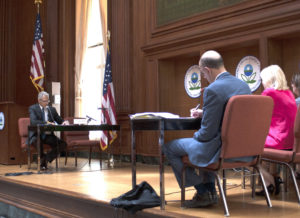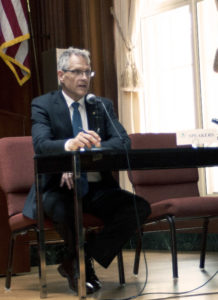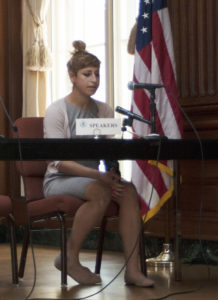BlueGreen Alliance Urges EPA not to Weaken Chemical Disaster Rule at Public Hearing
On June 14 in Washington, D.C., the Environmental Protection Agency (EPA) hosted its only public hearing on its proposal to weaken the Chemical Disaster Rule. BlueGreen Alliance National Director for Occupational and Environmental Health Mike Wilson and Executive and Program Assistant Alana Byrd were among the many witnesses urging the agency not to rollback the important protections included in the rule.
 The Chemical Disaster Rule was finalized in January 2017 and included key requirements for companies to take steps to prevent chemical releases, fires, and explosions, while also working with first responders to improve emergency preparedness and coordination. This rule would have helped protect workers, first responders, and the millions of Americans who live close enough to an industrial facility to be affected by a chemical accident. But the rule was put on hold almost immediately by EPA Administrator Scott Pruitt and, now, the agency is proposing to gut the rule, eliminating important provisions requiring:
The Chemical Disaster Rule was finalized in January 2017 and included key requirements for companies to take steps to prevent chemical releases, fires, and explosions, while also working with first responders to improve emergency preparedness and coordination. This rule would have helped protect workers, first responders, and the millions of Americans who live close enough to an industrial facility to be affected by a chemical accident. But the rule was put on hold almost immediately by EPA Administrator Scott Pruitt and, now, the agency is proposing to gut the rule, eliminating important provisions requiring:
- training and coordination between emergency responders and facilities;
- learning from mistakes by looking back at accidents or near-misses to assess how to prevent them in the future;
- sharing information with communities on hazards at the facility and preparedness and evacuation procedures;
- ensuring that incident investigation reports are completed effectively, within twelve months;
- training of workers and supervisors at certain facilities;
- conducting independent audits for serious chemical accidents; and
- for the most dangerous subset of facilities, assessing the applicability of safer technologies and practices so that if a problem occurs (whatever the cause), fewer people will be killed or injured.
 Wilson, a former fire fighter, paramedic, and EMT noted particular concerns with the proposed rule’s elimination of the requirements related to emergency response. “EPA’s proposed changes will endanger the lives of my former co-workers in the U.S. fire service, and they will endanger workers and millions of community members and their families who live around our nation’s chemical facilities,” Wilson said.
Wilson, a former fire fighter, paramedic, and EMT noted particular concerns with the proposed rule’s elimination of the requirements related to emergency response. “EPA’s proposed changes will endanger the lives of my former co-workers in the U.S. fire service, and they will endanger workers and millions of community members and their families who live around our nation’s chemical facilities,” Wilson said.
EPA has estimated that roughly 177 million Americans live close enough to an industrial facility to be affected by a chemical accident, and that risk falls disproportionately on low-income and minority communities. Additionally, one in three schoolchildren currently attends a school in the vulnerability zone for an industrial chemical accident. There are also countless workers at industrial facilities who walk into potentially dangerous situations every day and first responders who put their lives on the line whenever an accident does occur.

Serious chemical accidents are preventable if the necessary precautions and actions are taken, and yet serious industrial chemical accidents continue to occur every two-and-a-half days across our nation. Numerous chemical incidents have occurred since the rule was placed on hold.
“Since just the beginning of this year, 19 known chemical disasters have occurred, resulting in death and injury that might have been prevented had the Chemical Disaster Rule been in place,” Byrd said. “And if the rule is rescinded entirely, workers, first responders, and the millions of Americans who live in the vulnerability zone of an industrial chemical release will remain at risk.”
EPA’s proposal reflects a disregard for the safety of American workers, who are hurt “first and worst” when a refinery or chemical facility owner fails to invest in modern engineering practices to prevent a fire, explosion or release, or to respond to workers’ concerns about the need for maintenance or corrective action. The Chemical Disaster Rule will genuinely improve public safety and must be pushed forward in its original form, not weakened or delayed as the administration has proposed.